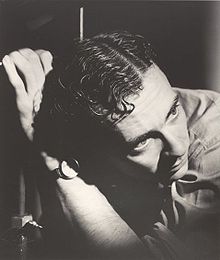Max Dupain
| Max Dupain | |
|---|---|

Dupain in 1937
|
|
| Born |
Maxwell Spencer Dupain April 22, 1911 Ashfield, Australia |
| Died | July 27, 1992 (aged 81) |
| Nationality | Australian |
| Occupation | photographer |
| Notable work | Sunbaker |
| Parents |
|
Maxwell Spencer Dupain AC (22 April 1911 – 27 July 1992) was an Australian modernist photographer.
Dupain received his first camera as a gift in 1924, spurring his interest in photography. He later joined the Photographic Society of NSW, where he was taught by Justin Newlan; after completing his tertiary studies, he worked for Cecil Bostock in Sydney.
By 1934 Max Dupain had struck out on his own and opened a studio in Bond Street, Sydney. In 1937, while on the south coast of New South Wales, he photographed the head and shoulders of a friend, Harold Salvage, lying on the sand at Culburra Beach. The image, entitled Sunbaker, subsequently became Dupain's most famous piece.
However, it was not until the 1970s that the photograph received wide recognition. It was purchased in 1976 by the National Gallery of Australia in Canberra and has become a national icon.
During World War II Dupain served with the Royal Australian Air Force in both Darwin and Papua New Guinea helping to create camouflage.
The war affected Dupain and his photography, by creating in him a greater awareness of truth in documentary. In 1947, these feelings were reinforced when he read a book Grierson on Documentary which defined the need for photography without pretence. The catchcry was "the creative treatment of actuality". Dupain was keen to restart the studio with this new perspective and abandon what he called the "cosmetic lie of fashion photography or advertising illustration". Refusing to return to the "cosmetic lie" of advertising, Dupain said:
"Modern photography must do more than entertain, it must incite thought and by its clear statements of actuality, cultivate a sympathetic understanding of men and women and the life they live and create."
Dupain's documentary work of this period is exemplified in his photograph "Meat Queue". He used a more naturalistic style of photography, "capturing a moment of everyday interaction [rather than] attempting any social comment".
...
Wikipedia
